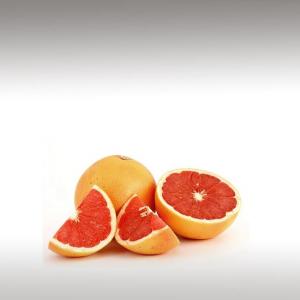
GRAPEFRUIT ESSENTIAL OIL (CITRUS X PARADISI) - ESSENTIAL OILS

BASE / GENERAL DATA
Information submited: April 14, 2015 Modified: March 13, 2018 By: OperaDreamhouse
Botanical Name: Citrus x paradisi
Common Method of Extraction: Cold-pressed
Part Typically Used: Fresh peel
Color: Pale yellow or light ruby
Consistency: Thin
Perfumery Note: Top / Middle
Strength of Initial Aroma: Sharp refreshing smell
The Grapefruit (Citrus × Paradisi) is a subtropical citrus tree known for its sour to semi-sweet fruit, an 18th-century hybrid first bred in Barbados. When found, it was named the "Forbidden Fruit", and it has also been misidentified with the Pomelo or Shaddock (Citrus Maxima).
The evergreen Grapefruit trees usually grow to around 5 - 6 meters tall, although they can reach 13 - 15 m. The leaves are glossy dark green, long (up to 15 centimeters). The fruit is yellow - orange skinned and generally an oblate spheroid in shape, it ranges in diameter from 10–15 cm.
The flesh is segmented and acidic, varying in color depending on the cultivars, which include white, pink and red pulps of varying sweetness (generally, the redder varieties are sweeter).
One ancestor of the grapefruit was the Jamaican Sweet Orange (Citrus Sinensis), itself an ancient hybrid of Asian origin, the other was the Indonesian Pomelo (Citrus Maxima). One story of the fruit's origins is that a certain "Captain Shaddock" brought Pomelo seeds to Jamaica and bred the first fruit. However, it probably originated as a naturally occurring hybrid.
Originally from Asia, it is now cultivated in the USA, Brazil and Israel.
Like all Citrus oils, Grapefruit oil should be used within six month of purchase.
Chemical structure:
The principle constituents that yield the properties sought are limonene, which is the bulk. With the others being citral, cadinene, paradisola-pinene, sabinene, myrcene, geraniol, linalool, citronellal, decyl acetate, neryl acetate and terpinen-4-ol.
Common Method of Extraction: Cold-pressed
Part Typically Used: Fresh peel
Color: Pale yellow or light ruby
Consistency: Thin
Perfumery Note: Top / Middle
Strength of Initial Aroma: Sharp refreshing smell
The Grapefruit (Citrus × Paradisi) is a subtropical citrus tree known for its sour to semi-sweet fruit, an 18th-century hybrid first bred in Barbados. When found, it was named the "Forbidden Fruit", and it has also been misidentified with the Pomelo or Shaddock (Citrus Maxima).
The evergreen Grapefruit trees usually grow to around 5 - 6 meters tall, although they can reach 13 - 15 m. The leaves are glossy dark green, long (up to 15 centimeters). The fruit is yellow - orange skinned and generally an oblate spheroid in shape, it ranges in diameter from 10–15 cm.
The flesh is segmented and acidic, varying in color depending on the cultivars, which include white, pink and red pulps of varying sweetness (generally, the redder varieties are sweeter).
One ancestor of the grapefruit was the Jamaican Sweet Orange (Citrus Sinensis), itself an ancient hybrid of Asian origin, the other was the Indonesian Pomelo (Citrus Maxima). One story of the fruit's origins is that a certain "Captain Shaddock" brought Pomelo seeds to Jamaica and bred the first fruit. However, it probably originated as a naturally occurring hybrid.
Originally from Asia, it is now cultivated in the USA, Brazil and Israel.
Like all Citrus oils, Grapefruit oil should be used within six month of purchase.
Chemical structure:
The principle constituents that yield the properties sought are limonene, which is the bulk. With the others being citral, cadinene, paradisola-pinene, sabinene, myrcene, geraniol, linalool, citronellal, decyl acetate, neryl acetate and terpinen-4-ol.

SPIRITUAL PRACTISES DATA

MEDICINE / HEALTH DATA

BEAUTY / COSMETICS DATA

FOOD / COOKING DATA
COMMENTS
No comments.


